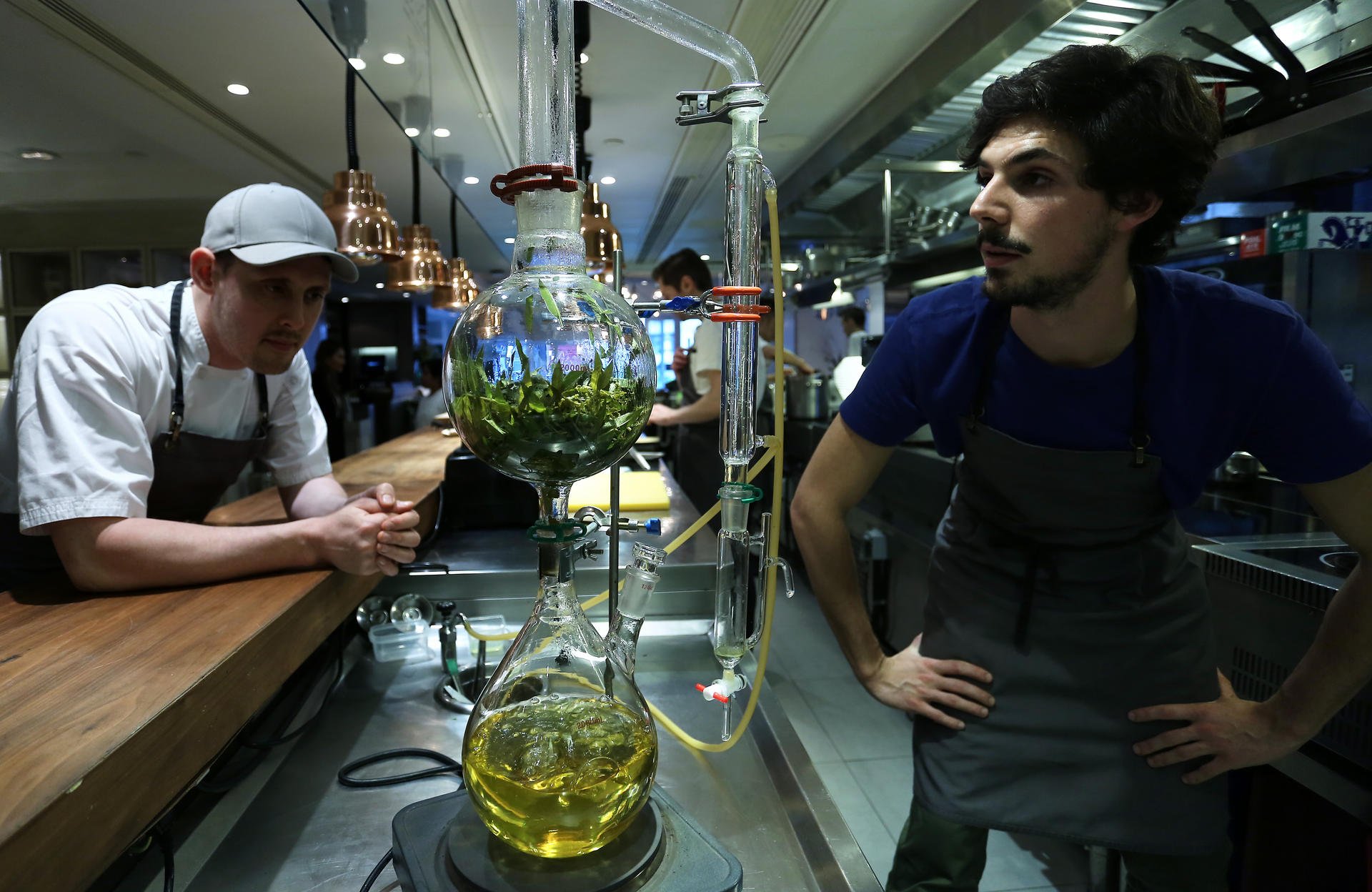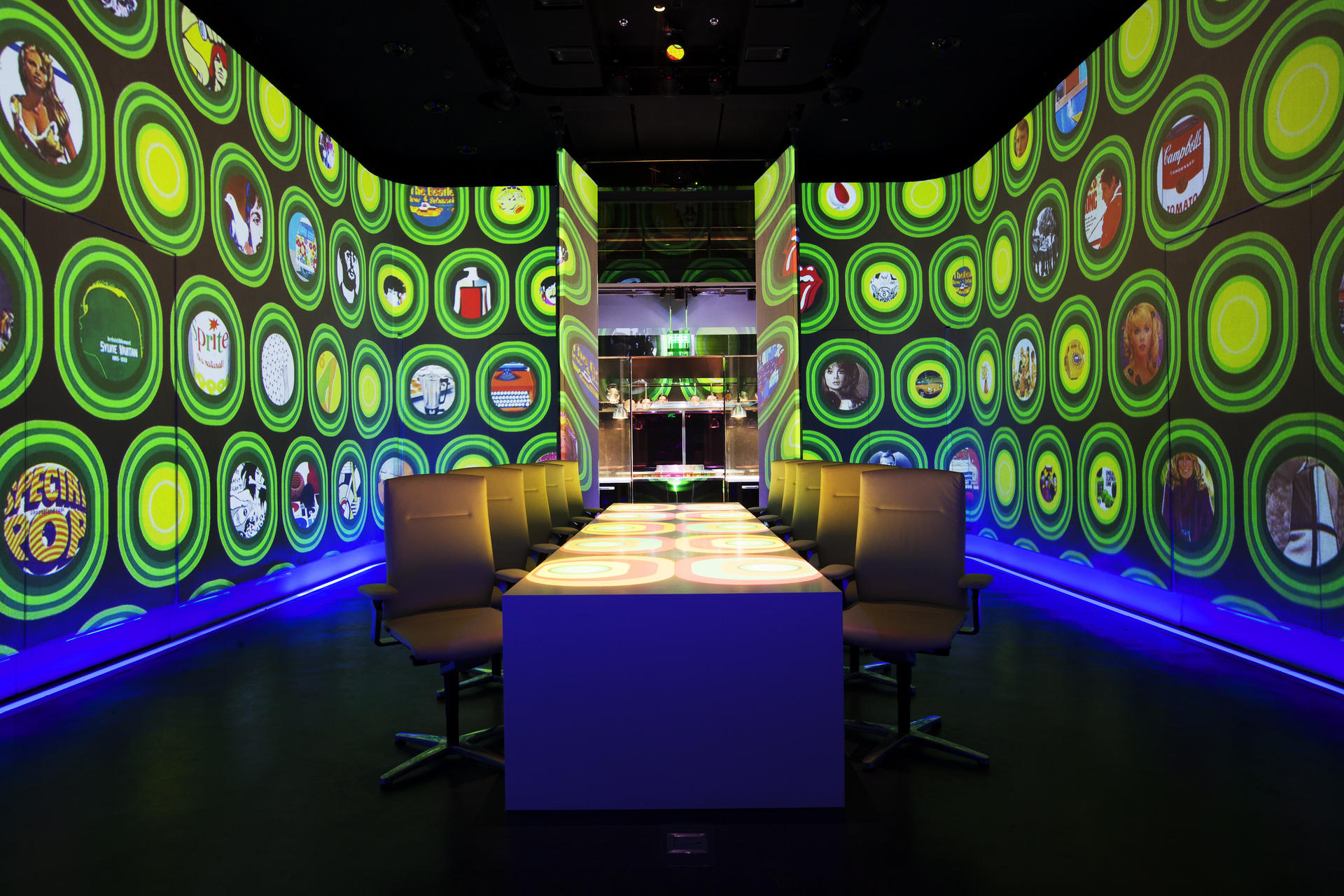Diners of the future will feast on 3D printed food and 'bespoke' cuisine

Imagine a restaurant of the future: the space is large and airy, with lighting in soft purple, the walls alive with moving images. You’re welcomed with Champagne served in a laboratory cylinder. The hors d’oeuvres – olive “caviar” – are green spheres that gleam and quiver on spoons curved at the handle, reminiscent of a Mobius strip. You take a seat on a stool that glows aquamarine. Your table is set with silicone cutlery on placemats inspired by circuit boards. First course, a guacamole flower printed delicately from the 3D printer that sits on your table.
Sound like something from a sci-fi film? Au contraire, the restaurant already exists: this summer a London pop-up served a nine-course, 3D-printed dinner for £250 (HK$2,540) per head. The cutlery, crockery, lights, chairs and food all came out of a printer, the food printed live in front of diners.

Food Ink is an international team that includes chefs Mateu Blanch and Joel Castanyé from Barcelona hot spot La Boscana, a restaurant known for its avant-garde take on cooking. While the technology involved in the 3D-printed restaurant is cutting edge, the food itself is reassuringly old-fashioned.
“The food is made from all-natural ingredients. It’s more healthy and nutritious than food served in most other restaurants,” says Antony Dobrzensky, one of the founders of Food Ink.
They make a paste of naturally medicinal plants, flowers, and herbs from the hills outside Barcelona, and combine this with the other ingredients in the printer cartridge.
“You can make things as vitamin-enriched as you want,” Dobrzensky says.

A focus on nutrition is what most food experts see as one of the defining dining trends of the future. Dobrzensky even speaks of a time when every home will have a 3D printer, controlled via your phone: send it instructions so that dinner is on the table as you walk through the door, your meal containing the optimal balance of minerals, vitamins and protein based on the chemical analysis undertaken by your toilet that morning.
Tailoring what you eat to what you are has already begun. The present trend of “free from” – gluten free, lactose free, carb fee, and so on – is in its infancy. With personal health big data, and your own genetic information, now easily accessible, those with heart disease in the family, for example, can eat to minimise risk.
Last month, Sai Ying Pun’s Locofama organic restaurant launched Locofamacy, a natural pharmacy and supplements shop that offers health tests, food allergy tests, genetic analysis, and hair analysis for reading toxin and mineral levels. The restaurant uses a nutritionist and Chinese medicine expert to design their seasonal menus.

“Our nutritionist will design personalised meal plans based on these new tests,” says Larry Tang, one of the founders of Locofama. “We will create customised meal plans for heart disease and cancer patients, for example. We’re also talking to gyms about super foods, and how to design meal plans for fitness and wellness needs.”
With this trend for the acute personalisation of dining comes the elevation of the ingredient.
Our relationship to food is set to become both much more personal and ethical
“We’ll see more artisan ingredients, and small, focused geek-like producers doing exceptional ingredients,” says Richard Ekkebus, director of culinary operations and food and beverage at Amber, the signature restaurant at the Landmark Mandarin Oriental hotel in Central now rated 20th in the World’s Best 50 Restaurants. “Vegetables will rule and take a more prominent place on menus.”
Rock star farmers are set to compete with the present cult of the superstar chef. These sought-after farmers will supply to high-end restaurants more focused on a single craft or ingredient, from a rare strain of Peruvian grain to sustainably farmed Namibian crayfish or organically grown artichokes.
Ten years from now, farming may be a much more local phenomenon.” Charles Banks, co-founder of London-based food think tank, The Food People, points out that in 10 years, when 8.15 billion people call our crowded planet home, global warming will have turned vast swathes of land into desert, while other areas will be prone to devastating floods.
There will be more “local farmed fresh produce”, he says. “Hydroponic farming will come into its own with year-round production without disease, insect damage and evaporation.”
This hydroponic farming will make us lose all sense of the seasonality of fresh produce.
When it comes to meat, he believes that “fresh produce” will be the preserve of the wealthy: most meat will be grown in vast laboratories using cellular culturing techniques, while luxury diners will flock to restaurants serving protein from real animals.

“The taste and texture of cultured meat will be identical but it will be healthier with lower cholesterol and higher antioxidants. The protein gap will also be filled with plant- and insect-based proteins which are better for the environment,” he says.
An awareness of how what we eat affects the environment is another major groundswell that will only become more pronounced. Ekkebus believes that luxury restaurants of the future will have to be “sensitive to their carbon footprint and responsible citizens … they will use their own high-end filtered water, recycled FSC paper and biodegradable straws”, for example, and fair trade products will be the norm.
Diners of the future will demand full farm-to-table transparency. Digital technology will be valuable here, with diners accessing information on where each ingredient comes from, and whether it was organically and ethically farmed.
“Gastronomy has mainly been about playing with techniques. But the ingredient is going to become the new hero. Diners will expect to be able to access data on every step of food chain,” Tang says.
The message is clear: dining out in the future will no longer be just about the pleasure of eating. Our relationship to food is set to become both much more personal and ethical.

3D printer turns food into a paste and nutrients can be added
The machines used at Food Ink’s 3D-printed restaurant are the world’s first multimaterial portable 3D printers. Made by Dutch company ByFlow, they have changeable printheads, and flip closed so they can be carried in a suitcase. The printers can print an array of materials including silver, nylon, silicone, plastic and, of course, food.
“The 3D printing of food is certainly fun, and you can make shapes that are impossible to do by hand, or that a chef doesn’t have the time to do as a regular dish,” says Nina Hoff, CEO of ByFlow.
“A printer obviously doesn’t know anything about flavour. So we explained to the chefs of La Boscana and the Food Ink team what the printer can do, and they developed dishes with great taste and texture.”
Any food going into the 3D printer is first made into a paste, be that raw or cooked. For chicken, for example, they put fresh raw chicken into a blender, and add seasoning and fresh herbs. They then print it onto a plate warmed to 50 degrees. They then oven-cook or fry the meat.
“It’s the exact texture of a chicken nugget,” Hoff says. “It’s all natural without any processed ingredients. Our fish and chips and mashed potato is very good, too”
Hoff says that one of the most valuable applications of this new 3D printing technology is in the field of personal nutrition. As all food must first be made into a paste, it is easy to add nutrients such as Omega 3s or up the protein content, for example. This is especially beneficial to those with difficulty eating.
“Around 80 per cent of the elderly in The Netherlands have swallowing problems. The soft food from this printer is easy for them to manage,” Hoff says. “The best part, though, is you can control the shape of food – you can print carrot paste into the shape of a carrot. This makes eating much more appealing.”

Insects are a great source of protein as food
To make a 150g beef burger takes 3,290 litres of water; an equivalent insect burger takes less than half a litre. Weight for weight, crickets contain more protein than beef and are 15 to 25 times more efficient at converting their feed into food for us. Insects contain plenty of calcium, zinc, and omega-3 fatty acids and are low in cholesterol. These abundant critters are also easier to raise than livestock, and they produce less waste. With the growing strain on the planet’s resources, eating insects is not just likely, it’s imperative.
While 80 per cent of the world’s countries eat insects, in Western countries insects have generally been relegated to novelty street food stalls or specialised ethnic restaurants such as New York City’s Toloace Mexican restaurant, which serves grasshopper tacos.
Last year, Britain’s first dedicated insect restaurant opened serving everything from bug blinis to toasted cumin mealworms. You’ll also now find insect protein bars on Amazon and a variety of flours including earthworm, silkworm pupae and cricket.
It was in 2013 that French artisanal chocolate maker Sylvain Musquar made headlines when he sold handmade truffles topped with gold-plated crickets and worms. It was possibly the first time eating insects had been given a luxury spin.
Will we soon see insects adorning dishes at our favourite Michelin-starred hot spots?
Want more articles like this? Follow STYLE on Facebook

Restaurants are meeting a rising demand for special ingredients and full farm-to-table experience


